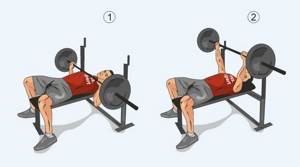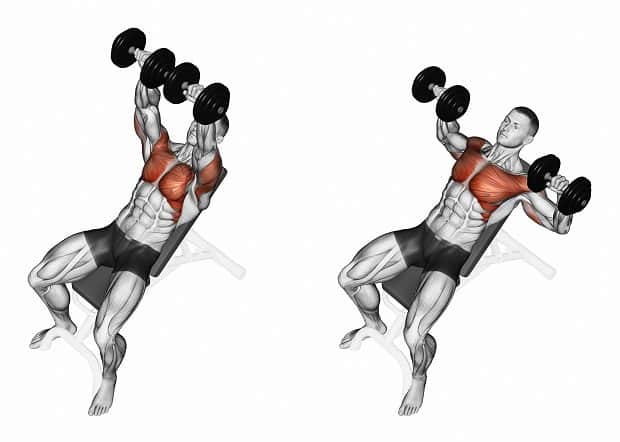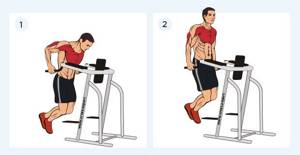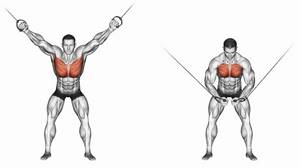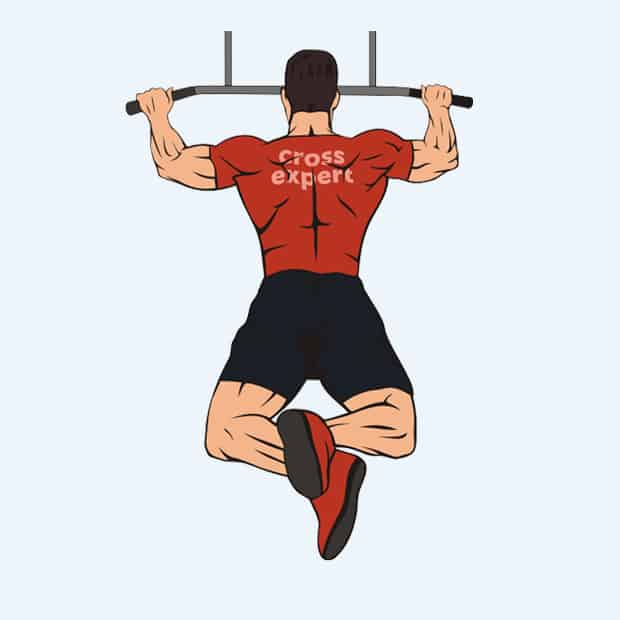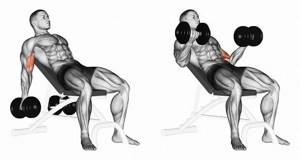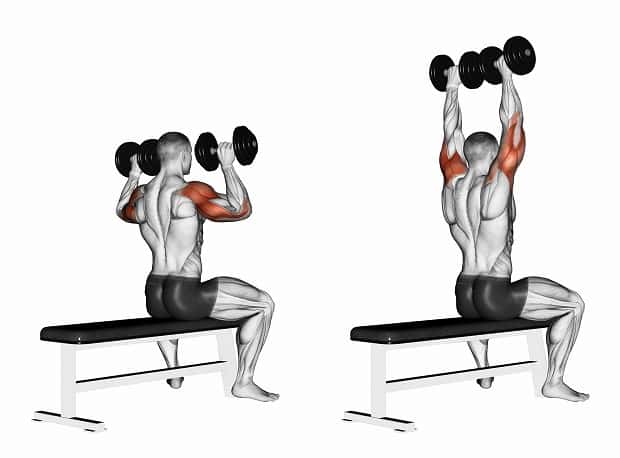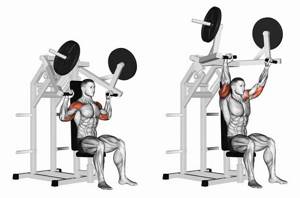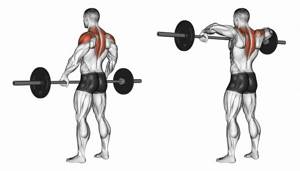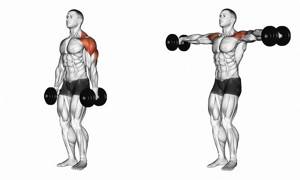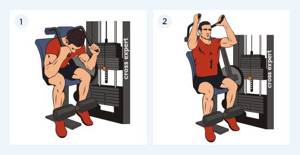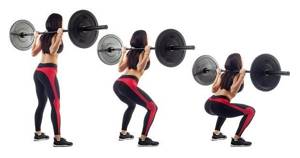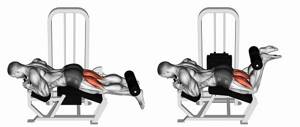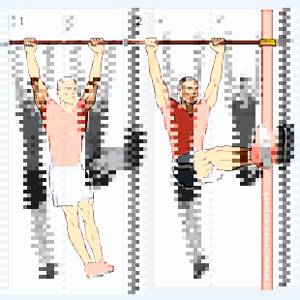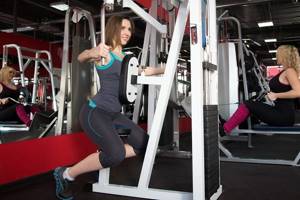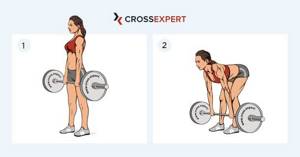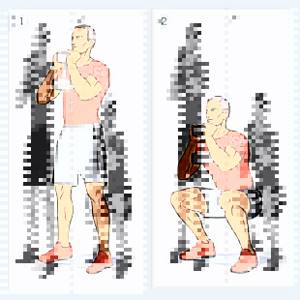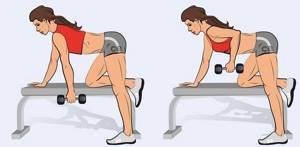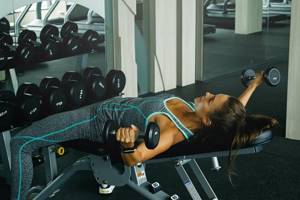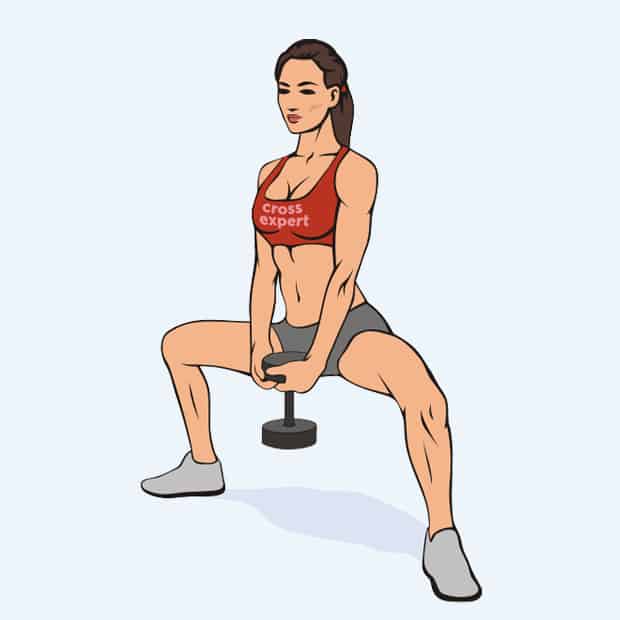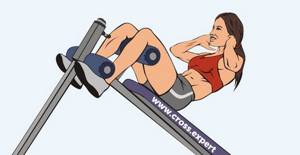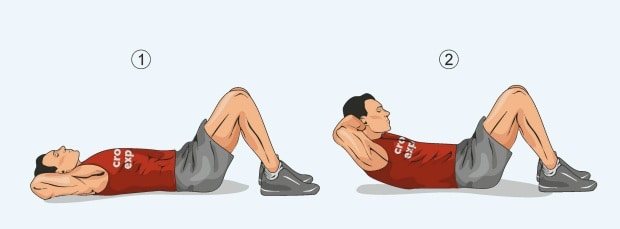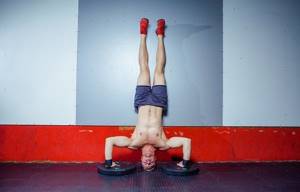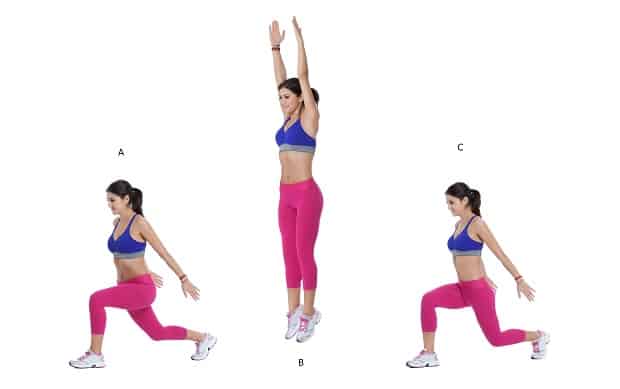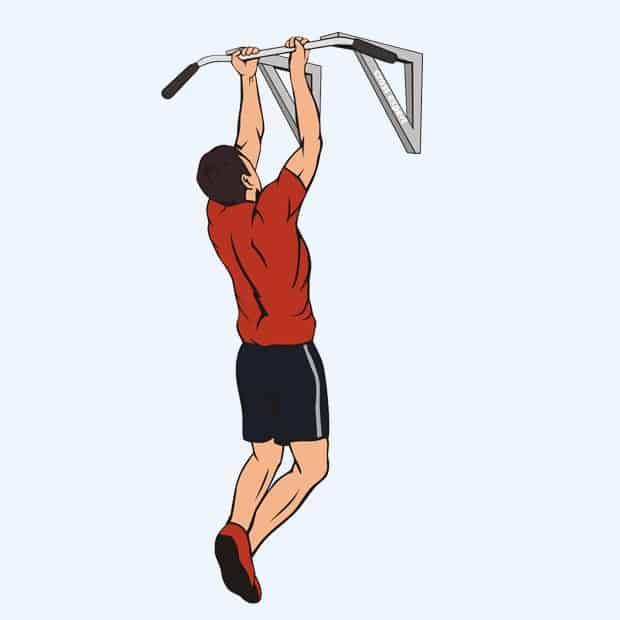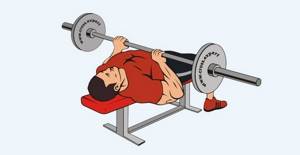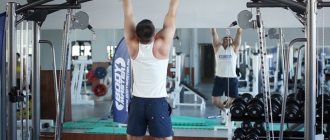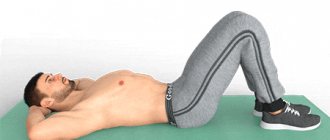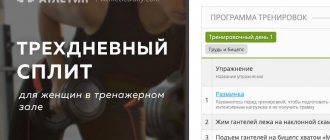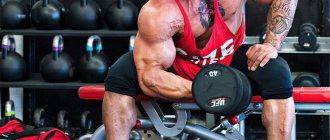Training programs
Why are we even talking about a training program?
Why is it needed and what is it? A training program, like any other program, is a plan, step-by-step instructions, following which we achieve our goal. Training according to the program gives our classes a systematic approach, disciplines and, to some extent, motivates. What alternative is there to the program?
This could be so-called intuitive training. With this approach, there is no pre-planned lesson plan, but it is obvious that this method is not suitable for everyone.
Even experienced athletes who use an intuitive approach to training, to one degree or another, adhere to a plan, albeit not as detailed as that of beginners, but at least which muscle group to pump on which day, how many days a week to train, and how much to rest they know clearly. And this, you see, is also a training plan, it’s just that the degree of detail is less due to the athlete’s vast experience.
Let's try to figure out what types of training programs exist. How can you classify them to understand which one is right for you? So, the programs can be roughly divided according to the location of the training.
Nutritional features and tips during terrain training
During the “drying” period, it is important to support your body with high-quality nutrition, but without excess, so that fat does not accumulate, but is burned. The following tips will help you create a fat-burning diet:
- The number of meals is from 4 to 7 . So the portions will be fractional, and the metabolic rate will be at a high level.
- It is necessary to reduce the calorie intake by 10-30% . It is impossible to give an exact figure; it is the same for each organism. You'll have to experiment a little. The first week will be difficult, the main thing is not to give up and stick to the diet.
- It is necessary to completely eliminate fast carbohydrates (except for fruits, which are necessary to maintain health). Forget about flour, sweets, alcoholic drinks, fatty foods, soda and processed foods.
- If you can’t eat, use sports nutrition , but don’t overuse it. These are just additives. From sports nutrition during drying you can use: protein, bcaa, vitamin kits.
- Support your body with vitamins and minerals . Vegetables and fruits cannot be excluded from the diet, otherwise health problems will begin due to a lack of vitamins.
- Carbohydrate foods should be taken before two o'clock in the afternoon . Afterwards only protein, some fat and fiber.
- Fats, despite their terrible name, cannot be removed from the diet . The lack of this important component in the diet will affect your health. You need to make up for the lack of fat with fish, supplements, olives, nuts, olive and flaxseed oil.
- Don't forget about water . You need to drink about two and a half liters of drinking water.
Follow these tips to create a detailed meal plan and stick to it. Now you know how to properly improve muscle definition while maintaining health.
Author: Full-Fit
Home training program
If the situation is such that classes in the gym are not suitable for you for some reason - lack of time, budget deficit, or finally simply the lack of a suitable hall for classes, then there is also a way out. You just need to choose a training program at home that suits your goals (which will be discussed below). Don't be too skeptical about this possibility. At home, even with your own weight, if you have a suitable training program, you can do a huge number of exercises for all muscle groups. And with minimal equipment, such classes will be little inferior to classes in the gym. So, working out at home is a great place to start on your journey to fitness.
Another way to classify training programs is based on gender.
Diet for weight and relief
When an athlete trains for weight, he must consume at least 2 grams of protein per 1 kg of body weight per day. Otherwise, there can be no question of any gain in muscle mass. This, of course, does not mean that you need to drink sports nutrition (proteins, gainers, etc.) ten times a day. First of all, you need natural food rich in protein. These are eggs (preferably boiled), meat (chicken, beef, turkey, etc.), fish. The presence of healthy natural food in the diet in the right amount will have a very beneficial effect on the growth of muscle mass. Sports nutrition can only act as a supplement, but not as a replacement for natural products. After training (within half an hour), you need to eat food rich in complex carbohydrates. This is buckwheat, oatmeal, barley porridge, spaghetti. A little later, you definitely need food rich in protein. When training for relief, it is necessary to reduce the consumption of foods rich in carbohydrates. This is especially true for simple carbohydrates (all kinds of sweets). You should also forget about fast food or reduce such food to the bare minimum. Food rich in fats and carcinogens is not only harmful, but also contributes to excess weight gain. In this case, there can be no question of any relief.

Training program for girls
Girls most often do not set themselves the task of building up huge muscle masses. And the physiological characteristics of the female body leave their mark on the principles of drawing up training programs for girls. Unlike men, training for girls does not involve working with huge weights and “failure” approaches. Although this does not mean that strength training is, in principle, not suitable for women. On the contrary, such programs have proven to be effective in achieving such typical female goals as, for example, enlargement of the gluteal muscles.
Training program for men
Training for men, in turn, can also vary depending on the tasks facing the athlete. If your goal is to lose fat and tone your muscles, then you should focus your attention on programs that involve circuit training with a lot of cardio. If you have set yourself a goal - to become big and powerful, you should focus on programs with an emphasis on heavy (relative to your level of fitness), basic movements. Choosing a training program depending on your goal. .
FIRST MASS, AND THEN RELIEF
From the formula described above, it is immediately clear that this training method is suitable for those whose weight is below the number calculated by the formula. Usually it is men who gain weight, women less often, with the exception of rounding the buttocks and creating athletic legs.
Therefore, this training method can be called in a historical manner - gladiatorial, and the first - the Cleopatra method ;). Remember that a fat mass gain of around 0.4-0.5 kg is considered normal. per 1 kg. pure muscle mass if you gain more fat. then pay attention to your diet.
Workout program for weight loss

In contrast to the previous group of programs, training aimed at “burning” excess subcutaneous fat uses a different type of energy exchange - aerobic, hence the priority in exercises - a large number of cardio loads. Moreover, you need to understand that the fat burning program does not impose a taboo on heavy basic exercises and vice versa. It all depends on your individual goals, level of preparedness and individual characteristics of the body.
Basic principles of terrain training
To fight fat, you will have to do cardio workouts, no matter how much you love them.
To increase motivation, let's talk about the benefits of cardio training over strength training in terms of fat burning.
When performing squats, a heavy basic exercise, glycogen and creatine are consumed, fat is not burned. It will not be possible to perform squats, even with an empty barbell, for a long period of time, and lipolysis (the process of burning fat) starts only with prolonged exercise. You can pedal a bike, use a rowing machine, or run for much longer than you can squat, deadlift, or bench press.
Cardio training should last from 20 to 60 minutes, depending on fitness and current condition.
Jogging in the fresh air will not only help you burn fat, but will also improve your health.
You shouldn’t forget about strength training, otherwise your hard-pumped muscles will begin to crumble.
In relief training, the weight will have to be reduced to 50-70% and the number of repetitions increased. Depending on the exercise, perform 12 to 20 repetitions. 12-15 repetitions in heavy basic exercises and up to 20 in isolating exercises for small muscle groups.
Weights are reduced to reduce the risk of injury, which increases due to the small amount of carbohydrate food consumed. The number of repetitions is increased so that the muscles continue to receive a good load and do not “crumble”.
Training program for terrain
So, you have passed the beginner's path. We completed our first program in the gym. You understand that you are already quite big, but there is no relief. The muscles are there, the tone is there, but I want to demonstrate my achievements in the upcoming beach season. You will need a training program to achieve relief. This program will largely overlap with the weight loss program, because... To achieve relief, obviously, you need to get rid of the subcutaneous fat that hides the muscles. The training program, depending on the level of fitness, will contain a large number of cardio loads and various types of circuit training.
Differences between mass training and relief training
One of the main differences is the number of repetitions in the approaches and the weight of the weights. If a person trains for weight, then, as a rule, the weight of the weights (barbell, weights, dumbbells, exercise machines) is selected in such a way that the number of repetitions is from 6 to 10. That is. in the first approaches (after the warm-up) 10 repetitions are performed, then the weight is slightly increased and 7–8 repetitions are performed, etc. When training for relief, the number of repetitions in sets is usually increased. When training for relief, there can be 12 – 15 or more repetitions. The main task here is to increase the intensity of the training. A terrain training program often includes exercise on a treadmill and cardio equipment. This helps reduce body fat.
Training program for beginners

A training program for beginners differs from programs for advanced athletes by a number of principles: - Technically complex, heavy exercises should be excluded at the initial stage (at least if you do not have a qualified coach or training partner working with you) - Closer attention should be paid to circuit training all muscle groups - The most common thing that beginners underestimate (although this is not directly related to training) is diet! The diet must be adjusted in accordance with the loads and goals set - Periodization of exercise. From a “scientific” point of view, periodization is not so important for beginners, since it is hardly worth expecting stagnation in the progress of a beginner who just came to the gym yesterday. BUT for beginners, until sport has become an integral part of their life, motivation is very important. And if you have a very monotonous, monotonous training program, there is a high chance that you will simply give up classes. Therefore, it is worthwhile from the very beginning to take care of the variety of your training - vary heavy strength training with CrossFit training, regular running with HIIT training.
How many reps to do for relief?
Many people are concerned about the question of how many repetitions to do for relief. It’s worth noting right away that the issue of muscle definition has more to do with nutrition than with training. In order to improve muscle definition, it is necessary to create a small calorie deficit in the body and eliminate sweets, smoked foods and other unhealthy foods. However, when training for terrain, it is traditional to perform more repetitions with light weights. High reps increase the amount of time your muscles are under tension, which improves endurance and helps you burn more calories. Thus, the question “how many repetitions should I do for relief?” is more correctly rephrased as “how many repetitions should I do for endurance?”
As mentioned above, to improve muscle endurance, it is necessary to perform a large number of repetitions in each approach (12 and above). This number of repetitions helps not only to increase endurance, but also to improve muscle definition, subject to proper nutrition, of course. How many repetitions do you think should be done for mass, strength and muscle definition? Write your answer in the comments.
Bodybuilding training program
Bodybuilders build their training programs on the following principles: 1. Dividing muscle groups into different days of the week (split) 2. Alternating heavy, high-volume training with high-intensity (pump loads) - periodization 3. Progression of loads. Only with a constant increase in load (in one form or another, not only in working weights) can we expect an increase in muscle mass.
Weekly training program - weekly split
A weekly split usually refers to a training program in which different muscles (muscle groups) are trained on different days of the week. For example: Mon. – Back W. – chest Wed. – Shoulders Thu. – Hands Pt. – Legs With this program we get a five-day split. As you understand, the split can be 4, 3 or even 2 days, when the muscles of the whole body are worked out in 2 days a week.
How many reps to do in a weight approach?
There is an opinion that to gain mass it is best to do 6-12 repetitions. This rep range actually promotes muscle fiber hypertrophy. However, this theory is already more than 60 years old and it is very conditional. A number of modern scientific studies have established that for muscle growth the number of repetitions is not as important as the time the muscles are under load, a gradual increase in working weights and training volume.
So, to increase muscle mass, it is necessary that each approach last about 30 seconds and end 1-2 repetitions before muscle failure. That is, if you perform an exercise with a very light weight for 30 seconds, it is unlikely that you will be able to build muscle mass. The working weight should be approximately 65-80% of one repetition maximum (1RM). That is why most often the answer to the question of how many repetitions to do is 6-12 repetitions. This is how many repetitions you can do in about 30 seconds with a working weight of 65-80% of 1RM.
However, in order to constantly progress, it is necessary to gradually increase the load. Without progression of the load, you will stagnate in one place. Therefore, in your next workout, try to either increase the working weight a little, or do more repetitions or sets. The main thing is not everything at once. The load must be increased gradually, otherwise you will drive yourself into a state of overtraining.
That is why experienced athletes keep a training diary, which allows them to effectively adhere to the principle of progression and periodization of loads. Any training program can be much more effective if you keep a training diary. Conversely, even the most effective training program may not meet your expectations without a diary. Draw the right conclusions.
Outdoor training program. Street workout
In addition to training in the gym, there are many programs for outdoor exercise - the so-called street workout. The advantages of such programs include their undoubted economic attractiveness - indeed, horizontal bars and parallel bars are available at many sites and all this is absolutely free. On the other hand, there is an obvious disadvantage in the conditions of our country - not many people will want to play sports outside in the rain or in the cold.
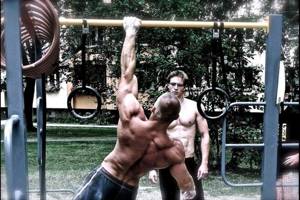
Terrain training program
Even the most powerful athletes without beautiful, pronounced muscle definition will not look fit and athletic. And if the percentage of fat in your body is approaching 20 (35-40 for women), then you urgently need cutting and an effective training program for relief. Of course, you will have to endure some hardships and restrictions, but the final result is worth it. You will look much more attractive in the eyes of the opposite sex and become an object of envy for those whose willpower is not so strong.
The terrain training program is designed for 2 goals:
- removal of fat layer
- drawing muscle relief
Thanks to the right approach, you will also be able to preserve muscle mass. If you follow the advice, within a couple of months your body will take on a completely different look.
Theoretical part
It is imperative to be well versed in the theory on this topic, otherwise it will be impossible to understand the essence of the training. Developing relief requires a slightly different approach, in contrast to exercises for strength and mass. The exercises will be approximately the same, but the approach to them will change. The goal in such a procedure is to lose fat and thereby create muscle definition, using exercises designed specifically for this. You also need to stick to a diet to make your workouts more effective.
No matter how sad it may be, losing body fat is impossible without losing some muscle mass. The body is designed in such a way that the process occurs at both levels. You can only make sure that the muscle mass is lost to a minimum, but otherwise you just have to take the characteristics of the body for granted.
To reduce the level of muscle mass loss, you will have to consume a large amount of protein plus add BCAAs to your diet. In addition to nutrition, you will have to devote time to heavy exercise - this way the muscles will always be toned and even slightly increase in volume.
How does fat loss occur?
Basically, diet will be involved in losing body fat, and exercise will also be needed in addition to it. They must comply with a training program for men to create a sculpted body.
The essence of the diet is to increase the amount of protein in the diet. Thanks to this, you can reduce your carbohydrate intake, minimize muscle loss, but at the same time begin to lose a layer of fat. Why there should be a lot of protein in the diet is clear - muscle preservation, but how reducing carbohydrates works needs to be explained.
Carbohydrates provide energy for the body. To engage in any physical activity, you need energy, that is, carbohydrates are actively spent on it. If the carbohydrate reserves in the body are too small, and energy is still needed, hated fats come to the rescue. Therefore, the unnecessary layer of fat slowly dissolves. For this reason, for terrain training to be effective, it is necessary to reduce your carbohydrate intake.
How to create a beautiful relief?
The period of gaining muscle mass is followed by careful work on the relief, with the goal of emphasizing the beautiful outlines of the muscles. At this time, a special program is carried out, combining it with drying - the process of burning subcutaneous fat while maintaining maximum muscle mass.
Professional bodybuilders dry most often twice a year: before the spring and autumn seasons. Accordingly, during the period of gaining muscle mass, you need to maintain a more or less dry shape - this way drying will proceed much easier. Two to three months is just enough to get in shape: reduce your waist size, improve muscle separation, make your stomach more prominent. The priority task during the drying period is to get rid of the subcutaneous fat layer to the maximum, while maintaining muscle volume and strength indicators.
This is achieved by creating a calorie deficit - we begin to spend more energy than we receive. This consists of the following components:
- switching to a low-carb diet;
- increasing training intensity;
- adding cardio exercise.
Naturally, these are only the general and most common components of drying. All athletes are individual, some manage to do without cardio, while others dry out on the same amount of carbohydrates that others gain. But the general trend is exactly this - cutting back on the amount of carbohydrates (and there is often a period right before a competition when their amount can reach zero), small changes in the training program and adding aerobic training.
There will certainly be small losses in muscle mass, but with proper nutrition with plenty of protein, they can be minimized. Pros use anabolic steroids for the same purpose. For amateurs, of course, it is better to do without them, although the loss in muscles will most likely be greater.
As for daily caloric intake, you need a deficit of 10-20% of the daily value. If you cut back even more, the body will try to get rid of the muscle first. The main thing is to accurately measure the number of calories, and not do it “by eye”. Kitchen scales and online food diaries will be of great help in such a situation. In nutrition, the main emphasis should be on proteins - 2-3 grams per kg of weight. It is advisable that all carbohydrates be complex. At the initial stage of drying, there should be at least 1.5 g per kg of weight.
Next, we will tell you what a relief training program should be like in the gym, how to correctly create it, and how to work on muscle definition at home.

© IEGOR LIASHENKO — stock.adobe.com
How does fat loss occur?
In addition to adjustments in training and exercises, you need to follow a strict diet. What's special about it?
- The daily protein intake is 2-3g per kg of body weight. Try not to eat more than 30-40g at a time, as more will overload your digestion.
- The amount of carbohydrates will need to be reduced. The norm of carbohydrates during relief training is 50-60g of carbohydrates per day. Within 1-2 weeks, reduce the amount of carbohydrate intake to the desired level, do not do it suddenly!
- Don't give up eating fat, but it shouldn't be too high. Keep their consumption low. 10% of calories should be allocated to fat.
- Be sure to buy various vitamin and mineral complexes, because the body will not receive them during the diet, which is not very good.
Features of terrain training
If you want to highlight muscle definition, the most important thing is to get rid of excess subcutaneous fat. And for this you need intense training and increased metabolic stress levels.
Ways to intensify your training
There are many options for intensifying the training process, for example:
- Reducing rest time between sets.
- Slow execution of the negative part of the amplitude.
- Performing forced reps with the help of a partner.
- Pause at the point of peak muscle contraction.
- Performing drop sets and supersets.
- Combining aerobic and anaerobic exercise in one workout.
- The static-dynamic nature of performing strength exercises and much more.
All this applies when working on terrain. These techniques make the muscles denser and stiffer, each muscle bundle is visually more prominent, and due to the intensive supply of blood to the working muscles, the veins become more visible. However, performing most of these techniques is not recommended for beginners.
Of course, the benefits for the body will only come with careful recovery. Give your muscles a rest, get enough sleep, and provide them with enough protein and complex carbohydrates. Consume sports nutrition, and then progress in burning fat will be more noticeable every week.
If you have gaps in at least one of these aspects, then such heavy and intense training will lead to overtraining and loss of muscle mass during the diet. It is not biologically beneficial for the body to retain excessive muscle volume when it is under constant stress. It will begin to “suck” amino acids from the muscles in order to somehow recover after such an intense load. As a result, muscle volume will inevitably decrease and strength indicators will decrease.

Rep range
Contrary to popular belief, a cutting training regimen does not involve only pumping for 15-25 repetitions. This approach will also be detrimental to your muscles. To maintain them to the maximum, you need to try to maintain your strength indicators. If you give the body a signal that you are reducing the working weights and switching to light training, it will immediately happily get rid of excess muscle mass, which is not needed for such training.
That is why it is necessary to leave all basic exercises in the same number of repetitions – 8-12. A smaller amount is also not necessary at this stage - this can lead to injury, since the joints are not in the best condition during drying.
The rest time between approaches when working on relief is the same as when working on weight. We try to rest for about a minute or two, during which time you will have time to catch your breath and bring your heart rate back to normal. For heavy sets of basic exercises (such as squats or deadlifts), you can increase the rest to three minutes - you are unlikely to have time to recover in a minute. In isolation, on the contrary, you can reduce the break time to 30-40 seconds.
To quickly replenish lost energy, it is recommended to drink 8-10 grams of BCAAs before, during and after strength training. If you are at the very beginning of cutting and have the opportunity to add fast carbohydrates to your diet, adding amylopectin to your training cocktail would be an excellent option. This will extinguish catabolic processes and give strength. If you only consume complex carbohydrates, then take them 1.5-2 hours before training.
Selection of exercises
The choice of exercises differs when working on relief, strength or mass. Often during drying, an athlete builds an interesting training scheme for himself, combining elements from different strength sports, crossfit, martial arts and fitness. To say it doesn't work would be a lie. This approach really increases the pace of training, significantly increasing calorie consumption.
In general, it is best to do something like this: about 70% are basic multi-joint exercises, the remaining 30% is isolated work. The base is done at the beginning of the workout with heavy working weights for 8-12 repetitions, and we “finish off” the target muscle groups with isolation, performing exercises in the range of 12-15 repetitions and using the training intensification techniques described above. Also try to “squeeze” the working muscle groups as much as possible in each repetition at peak contraction.
Cardio and other rules for terrain training
Working on muscle definition is not just about strength training.
This and, without fail, regular cardio (walking, running, swimming, orbitrek, cycling, rowing).
The purpose of strength training is to resist muscle burning. Which definitely happens when working on terrain. With the help of a barbell, they try to minimize this negative side effect.
The goal of cardio is to speed up the fat burning process. Plus additional energy costs.
As a result, the general structure of the training will be as follows:
- Each workout begins with a general warm-up lasting 5-10 minutes. Usually this is cycling or walking
- Strength training 4 times a week
- When performing strength exercises, the working weights are sure to decrease! This is due to two factors. The first is low glycogen levels in the body due to a low-carbohydrate diet. Second - minimal pauses between approaches (30-60 seconds)
- Immediately after strength training - cardio. Also, at least 4 times a week. Duration 30-40 minutes
- You can do additional cardio on iron-free days. Duration 40-60 minutes
- Such training puts a lot of stress on the body. If you begin to feel the accumulation of chronic fatigue. Necessarily! Take a break from all physical activity for 2-3 days!
After this you can continue training. Your body will thank you.
Program in the hall for men for 4 days
The gym gives us every opportunity to train with maximum efficiency and comfort while burning fat. We have all the necessary equipment at hand. There is no need to reinvent the wheel, just do basic, isolated and, if necessary, cardio exercise. For the soul, you can add something more functional. It is advisable to train with an experienced partner who will help complicate the training by helping with forced repetitions or providing insurance when working with heavy weights. The productivity of the training will only increase from this.
The terrain training program for men below includes 4 workouts per week. Each session lasts approximately 1-2 hours. This complex is suitable for athletes who already have extensive training experience. The program for beginners will be presented below.
| Exercise name | Number of approaches and repetitions | Photo |
| Monday (chest + triceps) | ||
| Bench press | 4x10 |
|
| Incline Dumbbell Press | 3x10 |
|
| Dips | 3x10-12 |
|
| Incline Dumbbell Flyes | 3x12-15 | © blackday — stock.adobe.com |
| Crossover | 3x12-15 |
|
| French bench press | 3x12 |
|
| Triceps extension with cable handle | 3x12-15 | © _italo_ — stock.adobe.com |
| Wednesday (back + biceps) | ||
| Wide grip pull-ups | 4x10-12 |
|
| Bent-over barbell row | 4x10 |
|
| Close-grip lat pull-down | 3x10 |
|
| Horizontal block pull | 3x10 |
|
| Hyperextension | 4x12-15 | © Makatserchyk — stock.adobe.com |
| Incline Dumbbell Curls | 3x10-12 |
|
| Arm curls on a block with a rope handle | 3x12-15 |
|
| Friday (shoulders) | ||
| Seated dumbbell press | 4x10-12 |
|
| Shoulder press | 3x12 |
|
| Wide grip barbell row | 4x12 |
|
| Swing dumbbells to the sides | 3x12-15 |
|
| Abductions for the rear delta in the butterfly simulator | 3x12-15 | © fizkes — stock.adobe.com |
| Leads to the rear delta in a crossover from the upper handles | 3x12-15 | © Makatserchyk — stock.adobe.com |
| Crunches in the simulator | 4x12-15 |
|
| Saturday (legs) | ||
| Leg extensions in the simulator | 2x15-20, warm-up |
|
| Squats | 4x10-12 |
|
| Leg press | 3x10-12 |
|
| Leg extensions in the simulator | 3x12-15 | © Makatserchyk — stock.adobe.com |
| Deadlift on straight legs | 4x10 | |
| Leg curls in the simulator | 4x12-15 |
|
| Standing calf raises in the machine | 4x12-15 |
|
| Hanging Leg Raises | 4x10-15 |
|
You also need to add cardio training. Their quantity depends on the stage of drying and the amount of excess fat. You can start with three workouts a week, doing cardio in the morning or after strength training for 30-40 minutes. Closer to competitions, athletes can perform daily aerobic exercise for an hour or more. Choose the duration and quantity of these workouts individually based on your fitness and form.
As for the type of cardio, most perform low-intensity monotonous work with a heart rate of 60-70% of the maximum. Another good option is shorter interval training, which alternates periods of high intensity with a heart rate of 80-95% of maximum and periods of low intensity or rest with a heart rate of 40-60%. Many studies show interval training to be more effective.
Iron Health
Spring is a special time for every athlete. Heavy strength training and unlimited nutrition are being replaced by high-repetition pumping training and a special diet, the purpose of which is to burn excess fat and provide muscle definition.
In magazines you can find a large number of training programs for “cutting”, but they are often compiled for athletes of a high level of training who practice almost daily training. In addition, even three times a day of training is presented in such magazines as a real hell, which is almost impossible to complete without anabolic steroids and specialized drugs. Nevertheless, everyone without exception wants to pump up for the summer.
Train your endurance!
Since we spent the fall and winter working on strength and mass, our bodies became accustomed to working in small rep and set ranges. In addition, the cardiorespiratory system is ideally suited to this regime. Meanwhile, the fight for relief involves a multi-repetition pumping training system, which requires endurance.
The training program that we will present below is a 6-week cycle, divided into 3 subcycles - 2 weeks each. Each subcycle differs from the previous one by an increased number of approaches and repetitions. Thus, we gradually increase the intensity of training, increasing the total tonnage. Since increasing the number of sets and repetitions is carried out smoothly, the cardiovascular system and muscles have time to adapt to the load, and you can easily increase the intensity of your workouts.
Another important feature of the program is the simplicity of the exercises included in it, that is, there are no specific exercises in special simulators, which may not be available in the average gym. The program contains well-known exercises that every athlete of average training level can do.
Relief training program for intermediate athletes
Cycle #1 – week 1,2
Monday (chest + biceps)
| Exercises | Approaches | Repetitions |
| Dumbbell Bench Press | 4 | 15 |
| Bench press | 3 | 12 |
| Crossovers on blocks | 3 | 15 |
| Dumbbell raises with supination | 3 | 15 |
| "Hammer" on Scott's bench | 3 | 12 |
| Curling your arms on a block | 3 | 15 |
| Any abdominal exercise | 3 | 20-25 |
Wednesday (legs + shoulders)
| Exercises | Approaches | Repetitions |
| Squats | 4 | 15 |
| Leg Curl | 3 | 15 |
| Leg extension | 3 | 15 |
| Arnold press | 3 | 12 |
| Seated dumbbell press | 4 | 15 |
| Raising arms to the sides while bending over | 4 | 15 |
| Any abdominal exercise | 3 | 20-25 |
Friday (back + triceps)
| Exercises | Approaches | Repetitions |
| T-bar row | 3 | 15 |
| Pull-down on the chest | 3 | 15 |
| Pulling to the chest on a block (narrow handle) | 4 | 15 |
| Dips | 4 | 12 |
| Close grip bench press | 3 | 15 |
| Extension of arms on a block | 3 | 15 |
| Any abdominal exercise | 3 | 20-25 |
Saturday Sunday
Interval running - 4-5 accelerations.
Cool-down run – 10 minutes.
P.S. to week. For example, if you started Monday with chest exercises, then next week start with biceps exercises. Cycle #2 – week 3.4
Monday (chest + biceps)
| Exercises | Approaches | Repetitions |
| Dumbbell Bench Press | 4 | 15 |
| Bench press | 3 | 12 |
| Crossovers on blocks | 4 | 15 |
| Dumbbell raises with supination | 3 | 15 |
| "Hammer" on Scott's bench | 3 | 12 |
| Curling your arms on a block | 4 | 15 |
| Any abdominal exercise | 3 | 20-25 |
Wednesday (legs + shoulders)
| Exercises | Approaches | Repetitions |
| Squats | 4 | 15 |
| Leg Curl | 4 | 15 |
| Leg extension | 3 | 15 |
| Arnold press | 3 | 12 |
| Seated dumbbell press | 4 | 15 |
| Raising arms to the sides while bending over | 4 | 15 |
| Any abdominal exercise | 3 | 20-25 |
Friday (back + triceps)
| Exercises | Approaches | Repetitions |
| T-bar row | 3 | 15 |
| Pull-down on the chest | 4 | 15 |
| Pulling to the chest on a block (narrow handle) | 4 | 15 |
| Dips | 4 | 12 |
| Close grip bench press | 3 | 15 |
| Extension of arms on a block | 4 | 15 |
| Any abdominal exercise | 3 | 20-25 |
Saturday Sunday
Interval running - 4-5 accelerations.
Cool-down run – 10 minutes.
P.S. to week. For example, if you started Monday with chest exercises, then next week start with biceps exercises.
Cycle #3 – week 5.6
Monday (chest + biceps)
| Exercises | Approaches | Repetitions |
| Dumbbell Bench Press | 4 | 15 |
| Bench press | 4 | 12 |
| Crossovers on blocks | 4 | 15 |
| Dumbbell raises with supination | 4 | 15 |
| "Hammer" on Scott's bench | 4 | 12 |
| Curling your arms on a block | 4 | 15 |
| Any abdominal exercise | 3 | 20-25 |
Wednesday (legs + shoulders)
| Exercises | Approaches | Repetitions |
| Squats | 4 | 15 |
| Leg Curl | 4 | 15 |
| Leg extension | 4 | 15 |
| Arnold press | 4 | 12 |
| Seated dumbbell press | 4 | 15 |
| Raising arms to the sides while bending over | 4 | 15 |
| Any abdominal exercise | 3 | 20-25 |
Friday (back + triceps)
| Exercises | Approaches | Repetitions |
| T-bar row | 4 | 15 |
| Pull-down on the chest | 4 | 15 |
| Pulling to the chest on a block (narrow handle) | 4 | 15 |
| Dips | 4 | 12 |
| Close grip bench press | 4 | 15 |
| Extension of arms on a block | 4 | 15 |
| Any abdominal exercise | 3 | 20-25 |
Saturday Sunday
Interval running - 4-5 accelerations.
Cool-down run – 10 minutes.
PS Change the order of doing the exercises from week to week. For example, if you started Monday with chest exercises, then next week start with biceps exercises.
Three-day terrain training for men
Three workouts per week according to the split scheme will be quite enough for full-fledged fat burning for athletes with average training experience. Still, four or more workouts per week are more suitable for experienced athletes, who often dry out with “support” that allows them to recover quickly.
| Exercise name | Number of approaches and repetitions | Photo |
| Monday (chest + anterior, middle deltoids + triceps) | ||
| Bench press | 4x10 | |
| Incline Dumbbell Press | 4x10 | © Makatserchyk — stock.adobe.com |
| Dips | 3x10-15 | |
| Crossover | 3x15 | © Makatserchyk — stock.adobe.com |
| Seated dumbbell press | 4x10-12 | © Makatserchyk — stock.adobe.com |
| Wide grip barbell row | 4x12-15 | © Makatserchyk — stock.adobe.com |
| French bench press | 4x12 | |
| Wednesday (back + biceps + rear deltoid) | ||
| Wide grip pull-ups | 4x10-15 | |
| Bent-over barbell row | 4x10 | © Makatserchyk — stock.adobe.com |
| Close-grip lat pull-down | 3x10 | © Makatserchyk — stock.adobe.com |
| Row of one dumbbell to the belt | 3x10 | |
| Hyperextension | 4x12-15 |
|
| Abductions for the rear delta in the butterfly simulator | 5x15 |
|
| Standing barbell curls | 4x10-12 | © Makatserchyk — stock.adobe.com |
| Friday (legs + abs) | ||
| Leg extensions while sitting in a machine | 2x15-20, warm-up | © Makatserchyk — stock.adobe.com |
| Squats | 4x10-12 | © Vitaly Sova — stock.adobe.com |
| Hack squats | 3x12 |
|
| Deadlift on straight legs | 4x10-12 |
|
| Leg curls in the simulator | 3x15 | © Makatserchyk — stock.adobe.com |
| Standing calf raises in the machine | 4x12-15 | © Makatserchyk — stock.adobe.com |
| Crunches in the simulator | 3x12-15 | |
| Hanging Leg Raises | 3x10-15 | |
And add the required amount of cardio loads.
An example of training for terrain[edit | edit code]
Here is an example of a program for 6 workouts per week to get relief.
Monday
BACK - STRENGTH (30 MINUTES, HEAVY WEIGHTS): horizontal lever row in the machine - 1x15, 1x10, 2x5-6 to failure BACK - FAT BURNING PART (30 MINUTES, LIGHT WEIGHTS): Pull-ups or vertical row -3×10-15 Horizontal row - drop set 3 x (15+15+15) (three sets with three weight drops of 15 reps with each weight) AUXILIARY MUSCLES: Hanging leg raises on a horizontal bar or abdominal crunches - 3 x maximum
Tuesday
CHEST - STRENGTH (30 MINUTES, HEAVY WEIGHTS): Lever press in the machine 1x15, 1x10, 2x5-6 to failure CHEST - FAT BURNING PART (30 MINUTES, LIGHT WEIGHTS): Barbell or dumbbell press incline bench - 3×10-15 Barbell press on a flat bench - drop set 3x (15+15+15) AUXILIARY MUSCLES: Standing calf raises - 3×20
Wednesday
LEGS - STRENGTH (30 MINUTES, HEAVY WEIGHTS): Leg press in the machine with high and narrow legs - 1x15, 1x10, 2x5-6 to failure LEGS - FAT BURNING PART (30 MINUTES, LIGHT WEIGHTS ): Leg press with wide stance or sumo squats - 3x10-15 Leg extensions - drop set 3 x (15+15+15) AUXILIARY MUSCLES: Hyperextension - 2x15-20
Thursday
DELTS - STRENGTH (30 MINUTES, HEAVY WEIGHTS): Lateral dumbbell lifts - 1x15, 1x10, 2x5-6 to failure DELTS - FAT BURNING PART (30 MINUTES, LIGHT WEIGHTS): Lifting dumbbells across the sides in an incline position - 3×10-15 Lower block row for deltas - dropset 3 x (15+15+15) AUXILIARY MUSCLES: Hanging leg raises on a horizontal bar or crunches for the abs - 3 x maximum
Friday
BICEPS - STRENGTH (30 MINUTES, HEAVY WEIGHT): Standing barbell curls - 1×15, 1×10, 2×5-6 to failure BICEPS - FAT BURNING PART (30 MINUTES, LIGHT WEIGHTS): Arm curls on the lower block – 3×10-15 Arm curls with dumbbells – drop set 3 x (15+15+15) AUXILIARY MUSCLES: Standing calf raises – 3×20
Saturday
TRICEPS - STRENGTH BODY (30 MINUTES, HEAVY WEIGHT): Arm extensions while standing on the upper block with a straight handle - 1x15, 1x10, 2x5-6 to failure TRICEPS - FAT BURNING PART (30 MINUTES, LIGHT WEIGHTS) : French press on the lower block -3×10-15 Bent-over arm extensions with dumbbells -dropset Zx (15+15+15) AUXILIARY MUSCLES: Hyperextension - 2×15-20
I AM CONFIDENT THAT ANYONE WHO REALLY STRIVES FOR THEIR GOAL CAN LOSE EXCESS FAT AND LOOK GREAT. IF SOMETHING DOESN'T WORK OUT FOR YOU, IT MEANS YOU HAVE MADE SOME MISTAKES IN YOUR DIET OR TRAINING THAT ARE INVISIBLE TO YOUR VIEW. BUT I GUARANTEE THAT TOGETHER WE WILL DEFINITELY ACHIEVE SUCCESS!
Relief program for girls
Trying to get rid of extra pounds, girls often structure the fat burning process completely incorrectly. The main mistakes: total starvation, many hours of super-intensive cardio training and group programs. Although this approach is absolutely wrong, it is widespread almost without exception. The reason for this is the yellow press and dubious articles by incompetent authors on the Internet.
The process of getting rid of excess fat should be smooth and systematic: a balanced diet with the right amount of macronutrients, a special relief training program for girls in the gym, dosed cardio and functional exercise, proper recovery and sleep. Only then will you achieve a strong, beautiful, sculpted and most importantly healthy body.
The program also includes four workouts in the gym for girls:
| Exercise name | Number of approaches and repetitions | Photo |
| Monday (quadriceps) | ||
| Leg extensions in the simulator | 2x15-20 (warm-up) | © Makatserchyk — stock.adobe.com |
| Squats with a barbell on your shoulders | 4x12 | © Vitaly Sova — stock.adobe.com |
| Goblet squats with dumbbells | 3x12 |
|
| Leg press in the simulator | 3x12-15 | |
| Leg extensions in the simulator | 3x15-20 | © Makatserchyk — stock.adobe.com |
| Standing calf raises in the machine | 3x12-15 | © Makatserchyk — stock.adobe.com |
| Hanging Leg Raises | 4x10-15 | |
| Wednesday (back + chest) | ||
| Wide grip pull-ups (can be done in a gravitron) | 4x8-12 | |
| Row of one dumbbell to the belt | 4x10 |
|
| Close-grip lat pull-down | 3x10 | © Makatserchyk — stock.adobe.com |
| Horizontal block pull | 3x10 | © tankist276 — stock.adobe.com |
| Hyperextension | 4x12-15 | © Makatserchyk — stock.adobe.com |
| Hand raises in the butterfly simulator | 3x12-15 |
|
| Incline Dumbbell Flyes | 3x12-15 |
|
| Friday (hamstrings + glutes) | ||
| Leg curls in the simulator | 2x15-20 (warm-up) | © Makatserchyk — stock.adobe.com |
| Deadlift on straight legs with a barbell | 4x12 | |
| Plie squats | 3x12 |
|
| Wide lunges with dumbbells | 3x10-12 |
|
| Leg curls in the simulator | 3x15-20 | © Makatserchyk — stock.adobe.com |
| Glute bridge with barbell | 4x12-15 |
|
| Swing your leg back in a crossover | 3x12-15 |
|
| Saturday (shoulders + arms) | ||
| Seated dumbbell press | 4x12 | © Makatserchyk — stock.adobe.com |
| Wide grip barbell row | 4x12-15 | © Makatserchyk — stock.adobe.com |
| Swing dumbbells to the sides | 3x12-15 | © Makatserchyk — stock.adobe.com |
| Abductions in the “butterfly” simulator | 5x12-15 | © fizkes — stock.adobe.com |
| Incline Dumbbell Curls | 4x12 | © Makatserchyk — stock.adobe.com |
| Overhead arm extensions with one dumbbell | 4x12 |
|
| Bench crunches | 4x10-15 |
|
Connecting cardio loads is completely similar to men.
Relief training program for men and girls
The weight for performing exercises is chosen independently by everyone, but wisely. The weight should be such that you can do the exercise with perfect technique, and not “this will do.” Rest between sets from 1.5 to 2 minutes.
In the programs, 3 exercises are allocated for large muscle groups, and 2 for small groups.
Exercise number of approaches X number of repetitions.
Monday
- Bench press 3-4x8-12
- Bench press (dumbbells) 3x15-20
- Reduction of arms on the chest exercise machine 3x15-20
- Biceps with barbell standing 3-4x8-12
- Biceps with dumbbells sitting 3x15-20
- Calm run for 20 minutes.
Tuesday
- Deadlifts – the first week, the second – pull-ups 3-4x8-12
- Upper block thrust 3x15-20
- Lower block thrust 3x15-20
- Bench press (close grip) 3-4x8-12
- triceps on a block with rope handle 3x15-20
- Easy jog 20 min.
Thursday
- Squats 3-4x8-12
- Extension 3-15x20
- Bending 3x15-20
- Seated barbell press 3-4x8-12
- Standing lateral raise of dumbbells 3x15-20
- Easy jog 20 min.
Home workout program
It's okay if you don't have the opportunity to go to the gym regularly. A relief training program at home will help you get rid of excess subcutaneous fat without special exercise equipment. The main thing in this matter is personal motivation.
We bring to your attention a weight loss complex in which the athlete performs exercises with his own body weight. If you have any sports equipment at home (horizontal bar, parallel bars, wall bars, dumbbells, weights, abdominal roller), feel free to include exercises with them in this program - it’s much more effective.
There will be a total of 3 workouts per week, all of them short but intense, approximately 30-45 minutes. They are performed in a circuit training format - one set of each exercise is done in turn, after which the athlete rests for 1-3 minutes, and then repeats the sequence from the very beginning. Start with three circles, then gradually increase their number to 5-7.
| Exercise name | Number of repetitions | Photo |
| Monday | ||
| Push-ups with wide arms | 15-20 | |
| Reverse push-ups | 15-20 |
|
| Jump Squats | 15-20 |
|
| Burpee | 10 |
|
| "Bicycle" lying on your back | 45 seconds |
|
| Elbow plank | 45 seconds | © Makatserchyk — stock.adobe.com |
| Wednesday | ||
| Plyometric push-ups | 10-15 | |
| Narrow push-ups | 15-20 |
|
| Single leg squats | 10-12 per leg | © Makatserchyk — stock.adobe.com |
| Burpee | 10 | © logo3in1 — stock.adobe.com |
| Crunches on the floor | 12-15 |
|
| Side plank | 45 seconds for each side | |
| Friday | ||
| Push-ups with legs elevated | 15-20 | |
| Handstand push-ups against a wall | 10-12 |
|
| Lunges with changing legs while jumping | 12-15 per leg |
|
| Burpee | 10 | © logo3in1 — stock.adobe.com |
| Reverse crunches | 10-12 | © artinspiring — stock.adobe.com |
| Pulling your knees to your chest in a plank | 10-12 per leg |
|
If you wish, you can also add cardio according to a similar scheme - it can easily be done outside (running, cycling) or even at home, jumping rope.
Training frequency
It is recommended to exercise frequently. From 4 to 6 workouts per week. Why is that? Relief training does not involve training with heavy weights and very hard training, after which rest is required. Rest is no longer needed physically, but psychologically.
The full cycle of programs below is designed for 1-3 months.

Terrain program for beginners
If you just came to the gym, but want to burn fat first and only then gain weight, a relief training program for beginners will help you. By the way, this is exactly the sequence that is recommended for those beginners who want to have an athletic look, but are quite overweight.
There will be two full-body workouts in total, when all muscle groups are worked out each session. These two workouts need to be alternated, and a total of three times a week. That is, for example, on Monday you do the first day, on Wednesday - the second, on Friday - again the first, on Monday of the next week - the second, and so on.
| Exercise name | Number of approaches and repetitions | Photo |
| First day | ||
| Bench press on a horizontal bench | 4x10 | |
| Row of one dumbbell to the belt | 4x10 | |
| Seated dumbbell press | 4x10-12 | © Makatserchyk — stock.adobe.com |
| Close-grip pull-ups | 4 to maximum |
|
| Leg press in the simulator | 4x10-12 | |
| Hyperextension | 4x12-15 | © Makatserchyk — stock.adobe.com/td> |
| Crunches in the simulator | 4x12-15 | |
| Second day | ||
| Close grip bench press | 4x10 |
|
| Wide grip pull-ups | 4 to maximum | |
| Incline Dumbbell Press | 4x10 | © Makatserchyk — stock.adobe.com |
| Wide grip barbell row | 4x12 | © Makatserchyk — stock.adobe.com |
| Deadlift on straight legs | 4x10-12 | |
| Calf raises in the gym | 4x12-15 | © Makatserchyk — stock.adobe.com |
| Hanging Leg Raises | 4x10-15 | |
This program, combined with a proper diet, will allow a beginner to lose weight and tone muscles. Cardio is added according to a similar scheme.
You shouldn't train this way all year round - it's too hard. Sooner or later, your body will fail - you can easily get injured, which will unsettle you for several months. The optimal duration of work on relief is 2-3 months.
What will you have to do to get relief?
Exercises for relief are not very different from exercises for mass and strength, there are only minor adjustments. The first of them concerns basic exercises - there are fewer of them, but the number of isolating ones increases. You will now have to use less kilograms for weights, but you will have to repeat the exercises more times. In this case, it is necessary to include aerobics in the training process. After each workout, you need to run for 20 minutes. This can be done on a treadmill, but it is better outside if conditions and weather permit.
Perhaps the question may arise why heavy basic exercises are needed in a relief program, because this is not a process of gaining mass. The explanation is simple - basic exercises are needed so that muscle mass and strength do not decrease significantly and are constantly in good shape. At the same time, basic heavy exercises consume a lot of the body’s energy, so fat will also be consumed along with carbohydrates. That is, the fat layer will slowly but surely leave the body.

Duration of training
Relief training time should not exceed 50 minutes. This can be explained by the fact that during this time, catrizol, a catabolic hormone, will be released into the body. This is what you need to lose fat and muscle mass. Mass loss occurs due to the fact that due to long-term and effective intensity training, carbohydrates, fats, and along with them proteins, which are the basis of human muscles, become energy sources. For this reason, in the case of contour training, spending a lot of time on it does not mean it will have a better effect on your body shape.
In order not to be left without muscle mass, but at the same time lose weight, it is recommended to consume BCAAs before or during training. In general, it is better to learn to understand sports nutrition - this will make life much easier and you will be able to create your own diet.
Frequency of classes
To be effective, you need to practice often. A minimum of training is needed 3 times a week. This intensity is explained by the fact that when working on relief, the body does not need much time to rest and recover. You need to rest mostly in terms of psychology, not physiology, since there will not be enough carbohydrates, and this is a lot of stress for an unprepared body. The best way to train would be: 2 days in a row of training, 1 day off, 2 days of training, and so on. The training program can take up to 3 months, depending on the initial data. The larger the fat layer, the more you will have to work to give your body definition. If this is necessary for the aesthetic appearance of the body, you need to repeat the classes in a couple of months.
Having familiarized yourself with the theory, you can move on to practical exercises. In exercises where special devices are used, you need to select a weight that will be easy to handle a given number of times without violating the rules of execution. You can rest for a minute between sets, and up to two minutes between exercises.
